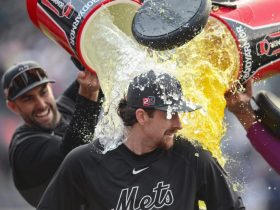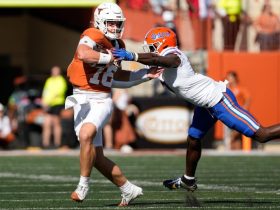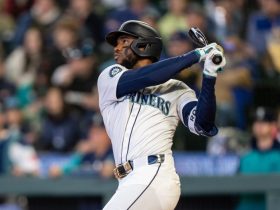NEW YORK — Every second that ticked away during the second half of Connecticut’s 75-60 win against Purdue this past April inched the Huskies closer to a place in college basketball history.
One year after winning the program’s fifth national championship, UConn went back-to-back by bulldozing through the NCAA tournament with an average margin of victory of 23.3 points per game, closing things out with that bravura performance against the Boilermakers. This placed the Huskies in rarefied territory, as just the eighth program to claim two championships in a row since the tournament debuted in 1939.
Of those eight teams, only one made further history by pulling off the three-peat: UCLA won seven in a row under coach John Wooden from 1967-73.
Amid college basketball’s intriguing list of preseason storylines, the Huskies’ quest to etch themselves into history alongside UCLA is impossible to ignore.
“The season that we’re about to embark on is rare in terms of what we can accomplish,” Connecticut coach Dan Hurley said at Big East media day.
Whether this achievement can be unlocked depends on how Hurley bolsters a roster trimmed by four players selected in this year’s NBA draft, two among the first seven picks.
There’s also a question of whether this is something any program can achieve in an era of deeper conferences, increased parity, rampant player movement in the transfer portal and an expanded tournament — factors Wooden and the Bruins never encountered throughout their dynasty.
Reloading while ‘returning basically no one’
Last season proved how quickly and capably Hurley and the Huskies can reload.
Integral pieces behind the 2023 national champions, including Jordan Hawkins, Andre Jackson and Adama Sanogo were gone, leaving UConn to build around an extremely talented but not entirely proven cast of returning contributors.
That blend of promise and inexperience was seen best in former center Donovan Clingan, who was extremely productive in a backup role as a freshman but would be asked to take on a substantially beefier role. Joining holdovers Clingan, guard Tristen Newton and forward Alex Karaban were a group of newcomers, led by freshman Stephon Castle and Rutgers transfer Cam Spencer.
Unlike during the 2023 season, when the Huskies caught fire in March, last year’s team spent seven weeks at No. 1 in the Coaches Poll before the final poll and won the Big East regular-season and tournament crowns in the same season for the first time since 2002. Combined with a dismantling of all comers in the NCAA tournament, UConn made a case for being included among the best teams in recent history.
Once again, Hurley will try to pull off an on-the-fly rebuild to keep the Huskies among the nation’s best.
“We’re returning basically no one,” he said. “It’s crazy, the amount of players we’ve cycled through. We’re so many players removed from just two years.”
Clingan is gone. So are Castle, Newton and Spencer. But Karaban, a junior, returns as a third-year starter after dabbling with the NBA draft. Senior guard Hassan Diarra and senior forward Samson Johnson will move from key supporting roles into the starting lineup, joining Karaban and impressive sophomores Jaylin Stewart and Solomon Ball.
“That’s one of the main reasons why I did come back,” Karaban said, “because I believe we have a great chance at chasing a three-peat and adding myself to history.”
UConn augmented this returning core through traditional recruiting and the transfer portal. One true freshman, five-star forward Liam McNeeley, should grab immediate playing time. Former Michigan forward Tarris Reed and former Saint Mary’s guard Aidan Mahaney, both juniors, are expected to lead the first wave off the bench.
Most importantly, the Huskies will bring back Hurley, who had an open flirtation this summer with the Los Angeles Lakers before opting to return to UConn on a six-year, $50 million contract extension through the 2029-30 season.
“It’s validation for the path I’ve taken to this point,” Hurley said. “I just have a lot of pride in my journey.”
IN-DEPTH: Season outlooks for every team in the preseason Top 25
SNUBBED: Five teams overlooked in the preseason poll that belonged in
The recent history of three-peat attempts
Five of the remaining seven back-to-back national champions in NCAA history came before the tournament expanded to 32 teams in 1975. The two to do have done so since the 64-team format debuted in 1985 either failed to advance deep into postseason play or missed the tournament entirely:
After winning in 1991 and 1992, Duke returned a roster with four eventual NBA draft picks, including guard Bobby Hurley and forward Grant Hill. But the Blue Devils tied for third in the ACC, were bounced in the quarterfinals of the conference tournament and then lost to California in the second round of the NCAA tournament.
Florida won in 2006 and 2007 under coach Billy Donovan and a veteran roster with six eventual draft picks, including longtime NBA standouts in forward Al Horford and center Joakim Noah. Ravaged by offseason losses, the Gators would miss the ensuing two NCAA tournaments and fail to advance out of the opening round until 2011.
History is clearly not on the Huskies’ side. But Duke presents an interesting parallel: The 1993 team, like this year’s Huskies, lost key starters — including one of the best in program history in forward Christian Laettner — but brought back enough talent and experience to be viewed entering the season as the favorite for the national championship.
“The expectation and the term ‘three-peat,’ yeah, that was definitely on our mind,” said Hill. “That was definitely the goal. And there was definitely the belief that we could do it.”
The Blue Devils were eventually undercut by injuries, the stress of taking every opponent’s best shot and the inherent difficulties in maintaining a championship-level performance behind a revamped lineup.
“In a way, it was easier when you were the hunter and not the hunted, you know,” said Hill. “The difference between year one and year two was that we really kept the same core of players. Going from year two to year three, attempting that third championship, it was a different challenge.”
Embracing the opportunity to make history
The same factors that tripped up those Blue Devils are heightened dramatically in college basketball’s current landscape. The biggest factor has been rampant player movement through the portal, which has made it harder to maintain success even among programs consistently ranked among the nation’s best.
“In today’s climate of college basketball, every year is like a new year,” Hill said. “It’s such a different world.”
But many things haven’t changed at UConn.
One is the Huskies’ intensity. Hurley has coached this group “harder than I’ve coached any other team,” he said, driven by the challenge of making history.
Another is the chip on the Huskies’ shoulder, unmoved if not increased in size despite the back-to-back national championships. Even with a roster loaded with top-shelf recruits and impact transfers, UConn has continued to lean into the us-against-the-world mindset that has propelled the program to rare heights.
“We walk around with that chip on our shoulders each and every day and we go about our business the right way,” Diara said. “Just the motivation to win three. Not being satisfied.”
And the expectations haven’t changed. Aware of how rare this opportunity comes around, the Huskies are leaning into the chance to make history.
‘I talk about the historic nature of our season pretty consistently because it’s the elephant in the room,” Hurley said. “You can’t hide from this opportunity.”






